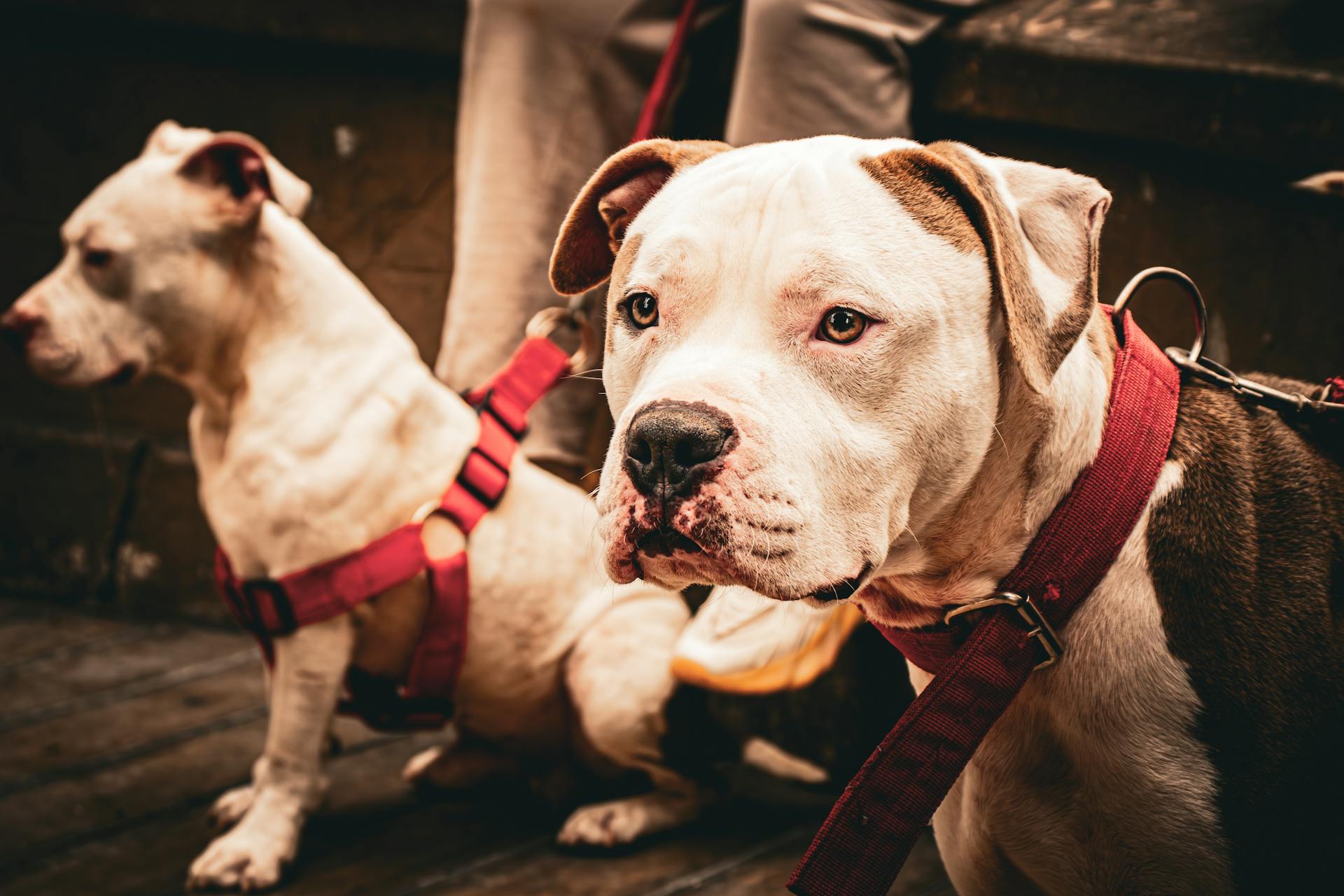
American Bulldog ear cropping is a surgical procedure that involves removing or altering the ear cartilage to give the dog a more distinctive appearance. The procedure is typically performed on puppies between 6 and 12 weeks old.
The American Bulldog breed has a long history of ear cropping, dating back to its origins in the 17th century. The practice was initially done to prevent ear injuries during dogfighting.
Ear cropping can be done for both functional and cosmetic reasons. However, some veterinarians and animal welfare organizations argue that it's unnecessary and can lead to complications.
Cropping is Controversial
Ear cropping is a topic that sparks a lot of debate among dog owners. The American Veterinary Medical Association (AVMA) opposes ear cropping when it's done solely for cosmetic purposes, a stance they've held since 1999.
Many countries have banned ear cropping, including Australia, most of Europe, and two Canadian provinces. In the United States, only nine states restrict the procedure, but no state completely bans it.
The American Kennel Club (AKC) recognizes ear cropping in some breed standards, but it's not required for registration. Some breed standards list a preference for cropped ears, like the Doberman Pinscher standard.
The Royal Society for the Prevention of Cruelty to Animals in Australia and the UK also oppose ear cropping. This is because the procedure can cause pain and potential complications.
Some breeders continue to crop ears for cosmetic reasons, even though it's not medically necessary. This is a concern for many people who believe that ear cropping is unnecessary and can harm dogs.
A law banning ear cropping was recently passed in Quebec and is set to take effect in February 2024. This is a step towards addressing the controversy surrounding ear cropping.
In the end, it's essential to consider the potential risks and consequences of ear cropping before making a decision.
On a similar theme: Bulldog Johnson Breed
Understanding Ear Cropping
Ear cropping in dogs has a long history, and it's still a topic of debate today.
Historically, breeds like the Miniature Pinscher and Brussels Griffon had their ears cropped to minimize the risk of injury while hunting.
The practice of ear cropping was also rooted in dog fighting, where fighters had their ears severely cropped to prevent opponents from biting their sensitive ears.
Some breeds, like Boxers, had their ears cropped to improve their hearing, but there's no evidence that ear cropping actually enhances a dog's hearing.
In fact, it's more likely that ear cropping decreases a dog's hearing acuity.
Many organizations, including the American Veterinary Medical Association and the Royal Society for the Prevention of Cruelty to Animals, oppose ear cropping due to the potential for pain and complications.
In some countries, like Australia and most of Europe, ear cropping is banned, and in the US, only nine states restrict the procedure.
Some breeders continue to crop their dogs' ears to maintain a cosmetic appearance, while others do it to honor the breed's historical function.
However, ear cropping is not medically necessary and can harm the dog.
If you're considering getting an American Bulldog, it's essential to ask your breeder about their stance on ear cropping and whether they perform the procedure for cosmetic or practical reasons.
Curious to learn more? Check out: All Types of Bulldog Breeds
Should You Crop Your Dog?
Most states still have veterinarians who offer ear cropping services, but any surgery is painful and proper veterinary care can help reduce this pain and risk of infection.
The American Veterinary Medical Association (AVMA) opposes ear cropping when done solely for cosmetic purposes, and they encourage the elimination of ear cropping from breed standards. They've had this policy in place since 1999.
Ear cropping is banned in the United Kingdom, Australia, and many European countries, and animal rights activists consider it unnecessary and a violation of an animal's rights.
Is Cropping Right or Wrong?
Ear cropping is a topic that sparks debate among dog enthusiasts, with some defending it as a necessary practice and others calling it cruel and unnecessary. The American Veterinary Medical Association (AVMA) opposes ear cropping for cosmetic purposes, a stance they've held since 1999.
The American Kennel Club (AKC), however, recognizes ear cropping as an acceptable practice that defines and preserves breed character. They emphasize that dogs with natural ears are not prohibited from entering dog shows, and more and more "natural" dogs are being successfully shown.
Animal rights activists consider ear cropping a violation of an animal's rights, and it's banned in the United Kingdom, Australia, and many European countries. The Royal Society for the Prevention of Cruelty to Animals in both Australia and the UK also opposes ear cropping.
In the United States, only nine states restrict ear cropping, but no state completely bans the procedure. Proponents of these laws cite pain, potential complications, and the lack of functional reasons to crop ears.
Some people prefer the look of certain dog breeds with cropped ears, but ear cropping is not medically necessary and may harm the dog. When selecting a breeder, ask about the procedure and choose one that aligns with your goals and values.
Should I Crop My Dog?
Ear cropping for dogs is still a common practice in many states, with some veterinarians offering the service.
Some veterinarians are willing to discuss the risks and aftercare with you, but it's essential to do your homework first.
Any surgery is painful for dogs, and proper veterinary care can help reduce this pain as well as the risk of infection.
Pico Rivera Animal Hospital, for example, is happy to discuss the risks and aftercare with you, but they do not perform ear cropping for dogs themselves.
You should consult with your veterinarian or get a few opinions first before making a decision.
Why People Crop Dogs
People crop the ears of certain breeds of dogs to meet a cosmetic appearance, sometimes to honor or replicate a putative function. Many breeds, such as the Miniature Pinscher and Brussels Griffon, were historically developed to be barn ratters and had their ears cropped to minimize the risk of injury.
The practice of ear cropping also has historical roots in dog fighting, where breeds like the American Pit Bull Terrier, American Staffordshire Terrier, and Staffordshire Bull Terrier had their ears severely cropped to prevent opponents from gaining an advantage.
Recommended read: American Staffy Dog Breed
Some breeders continue to crop the ears of these breeds to maintain the look related to their historic function, often to create a "tough" appearance. This closely cropped look has become synonymous with toughness, an attribute admired by fans of those breeds.
There's no evidence that ear cropping enhances a dog's hearing, despite the claim that dogs with erect ears have enhanced hearing compared to those with non-erect ears. Boxers, for example, traditionally had their ears cropped to improve their hearing for roles as working dogs.
In the past, some dog owners cropped their dog's ears for practical reasons, such as to improve hunting performance by preventing snagging on foliage.
For another approach, see: Dogs Ears Cropped
Dog Handling and Care
To care for your American Bulldog, it's essential to establish a daily routine that includes regular exercise and mental stimulation. This breed requires at least 30 minutes of exercise per day.
American Bulldogs are prone to obesity, so feeding them a balanced diet and monitoring their food intake is crucial. They need a high-quality dog food that meets their nutritional needs.
A clean living space is also vital for your dog's health and well-being. Regular grooming sessions can help prevent skin problems and reduce shedding.
Do Dog Shows Allow?

Do Dog Shows Allow Ear Cropping?
Ear cropping is allowed in dog shows, but only for specific breeds that have it as a standard. The American Kennel Club recognizes ear cropping as a practice integral to defining and preserving breed character.
The procedure should be done by a practicing veterinarian, not by dog owners or breeders themselves.
Dogs Handling
Puppies should be handled gently, especially when their ears are sensitive, as they contain many nerve endings.
Ear cropping, a common procedure for some breeds, is typically done when a puppy is between 6 and 12 weeks of age.
Analgesia is administered to minimize discomfort during the procedure, but it's not always provided.
Puppies should be kept calm and relaxed during the procedure to reduce the risk of pain and discomfort.
The ear pinna is very sensitive and should be handled carefully to avoid causing pain or injury.
After ear cropping surgery, puppies may need to wear an Elizabethan collar for months to protect the surgery sites and keep any supportive taping or posts in place.
Here's an interesting read: When Is It Too Late to Crop a Dog's Ears?
Post-operative pain management is necessary to prevent discomfort and promote healing.
Puppies require a significant amount of after-care, including regular bandage changes and warm compresses to soften scabs on the cut edges of the ear.
Infection and pain are common post-operative complications, so it's essential to monitor your puppy's condition closely and seek veterinary attention if you notice any signs of infection or discomfort.
Frequently Asked Questions
Is ear cropping illegal in the US?
Ear cropping is not federally illegal in the US, but some states have attempted to ban it. The legality of ear cropping varies by state, with opposition from some dog breed organizations citing health concerns.
Sources
- https://www.picoriveravet.com/site/blog/2022/10/30/ear-cropping-dogs
- https://www.thesprucepets.com/the-practice-of-cropping-dog-ears-1117848
- https://www.wiseowl.net/ear-crops
- https://www.whole-dog-journal.com/health/ear-cropping/
- https://www.dogster.com/dog-health-care/ear-cropping-in-dogs-and-why-its-bad
Featured Images: pexels.com


